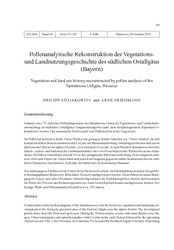Pollenanalytische Rekonstruktion der Vegetations- und Landnutzungsgeschichte des südlichen Ostallgäus (Bayern)
Stojakowits, Philipp
Friedmann, Arne
43: 55 - 82
Stojakowits, Philipp; Friedmann, Arne, 2013: Pollenanalytische Rekonstruktion der Vegetations- und Landnutzungsgeschichte des südlichen Ostallgäus (Bayern). In: TELMA - Berichte der Deutschen Gesellschaft für Moor- und Torfkunde, Band 43: 55 - 82, DOI: 10.23689/fidgeo-2867.
 |
Dokument öffnen: |
Abstract:
A radiocarbon dated pollen diagram of the Spitalmoos reveals the holocene vegetation and landscape development in the formerly glaciated area of the Eastern Allgäu near the alpine border. The investigated profile dates from the Preboreal up to now. During the Preboreal pine woods with some Betula cover the area. Ulmus immigrates and spreads together with Corylus in the early Boreal followed by the spreading of Quercus and Tilia. Later Fraxinus, Acer and also Picea reach the Northern Alpine Foreland. Depending on the site conditions, mixed oak forests rich in Ulmus and Tilia or forests dominated by Picea reign up to the Atlantic period. At about the same time Abies and Fagus immigrate. But Fagus prevails very slowly against the strong competition of already established tree species. Nevertheless Fagus becomes the dominant tree species in the Subboreal.
The human influence in the area is registered as from the Bronze Age. In the Subatlantic period three larger clearing phases (Roman Age, Middle Ages, Modern Era) were detected leading to the decline of Fagus and Abies stocks. Synchronous the non tree pollen values and especially the frequencies of Poaceae and anthropogenic indicators increase. Cerealia pollen were also identified. Zusammenfassung:
Anhand eines 14C-datierten Pollendiagramms des Spitalmooses kann die Vegetations- und Landschaftsentwicklung im südlichen Ostallgäuer Jungmoränengebiet nahe dem morphologischen Alpenrand rekonstruiert werden. Das untersuchte Profil reicht vom Präboreal bis in die Gegenwart.
Im Präboreal herrschen lichte Pinus-Wälder mit geringen Betula-Anteilen vor. Ulmus wandert ein und kommt im frühen Boreal zusammen mit Corylus zur Massenausbreitung. Nachfolgend breiten sich zuerst Quercus und Tilia sowie später Fraxinus, Acer und auch Picea aus. Je nach Standort dominieren entweder ulmen-, eichen- und lindenreiche Laubmischwälder oder von Picea beherrschte Wälder bis in das Atlantikum. Im frühen Atlantikum erreicht Picea ihre postglaziale Maximalverbreitung. Etwa zeitgleich wandern Abies und Fagus ein. Fagus kann sich jedoch nur langsam gegen die starke Konkurrenz bereits etablierter Baumarten durchsetzen, wird aber im Subboreal zur dominanten Baumart.
Der anthropogene Einfluss ist im Gebiet ab der Bronzezeit erfasst. Im Subatlantikum konnten drei größere Rodungsphasen (Römerzeit, Mittelalter, Neuzeit) nachgewiesen werden. Diese führen zu einem Rückgang der Fagus- und Abies-Bestände. Gleichzeitig nehmen die Nichtbaumpollen-Anteile und besonders die Werte der Poaceen und Kulturzeigerarten zu. Auch Getreidepollen konnte nachgewiesen werden. Der heutige Wald- und Offenlandanteil besteht seit ca. 250 Jahren.

